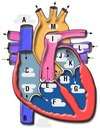Pulmonary Vascular Disease Flashcards
(77 cards)
What is a pulmonary embolism?
Thrombus forms in the venous system, usually in deep vains of the legs and embolises to the pulmonary arteries
How many hospital admissions are due to pulmonary embolisms?
1%
What can be the consequences of a massive pulmonary embolism?
Can be fatal
What can minor pulmonary embolisms be treated with and how is the prognosis?
Anticoagulation and have a very good prognosis
Where do pulmonary embolisms usually originate?
Deep vains in the legs

What are major risk factors of venous thromboembolisms?
Recent major trauma
Recent surgery
Cancer
Significant cardiopulmonary disease
Pregnancy
Inherited thrombophilia
What are symptoms of pulmonary embolism?
Pleuritic chest pain, cough and haemoptysis
Isolated acute dyspnoea
Syncope or cardiac arrest
What is haemoptysis?
Coughing up blood
What is coughing up blood known as?
Haemoptysis
What is dyspnoea?
Shortness of breath
What is shortness of breath called?
Dyspnoea
What is a syncope?
Temporary loss of consciousness
What is a temporary loss of consciousness called?
Syncope
What are the signs of a pulmonary embolism?
Pyrexia, pleural rub, stony dullness to percussion at base
Tachycardia, tachypnoea, hypoxia
Tachycardia, hypotension, tachypnoea, hypoxia
What is tachypnoea?
Abnormally rapid breathing
What is abnormally rapid breathing called?
Tachypnoea
What does VTE stand for?
Venous thromboembolism
What is a venous thromboembolism?
Condition in which a blood clot forms most often in the deep veins of the legs, groin or arm
What is used pre-test to determine the probability of a pulmonary embolism?
Well score
Revised Geneva score
What does the well score include?
Includes symptoms and signs of venous thromboembolism, previous venous thromboembolism and risk factors
What does the revised Geneva score include?
Based on risk factors, symptoms and signs
What investigations can be done for pulmonary embolism?
Full blood count, biochemistry, blood gases
Chest X-ray
ECG
D-dimer
CT pulmonary angiogram
V/Q scan
Echocardiography
Consider CT abdomen and mammography
Consider thrombophilia testing
What is an angiogram?
Used to visualise the inside of the lumen or vessels of the body
What is used to visualise the inside of the lumen or vessels of the body?
Angiogram















